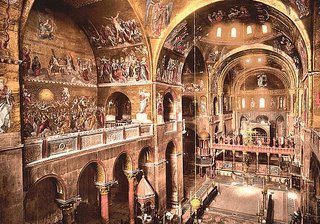CATS Memory - Elaine Paige
Friday, October 27, 2006
Sunday, October 22, 2006
Saturday, October 14, 2006
Thursday, October 12, 2006
The Verve- Bittersweet Symphony
Cause it's a bittersweet symphony, this life
Try to make ends meet
You're a slave to money then you die
I'll take you down the only road I've ever been down
You know the one that takes you to the places
where all the veins meet yeah,
No change, I can change
No change, I can change
But I'm here in my mold
I am here in my mold
But I'm a million different people
from one day to the next
I can't change my mold
No, no, no, no, no
Well I never pray
But tonight I'm on my knees yeah
I need to hear some sounds that recognize the pain in me, yeah
I let the melody shine, let it cleanse my mind, I feel free now
But the airways are clean and there's nobody singing to me now
No change, I can change
I can change, I can change
But I'm here in my mold
I am here in my mold
And I'm a million different people
from one day to the next
I can't change my mold
No, no, no, no, no
I can't change
I can't change
Cause it's a bittersweet symphony, this life
Try to make ends meet
Try to find some money then you die
I'll take you down the only road I've ever been down
You know the one that takes you to the places
where all the things meet yeah
You know I can change, I can change
I can change, I can change
But I'm here in my mold
I am here in my mold
And I'm a million different people
from one day to the next
I can't change my mold
No, no, no, no, no
I can't change my mold
no, no, no, no, no,
I can't change
Can't change my body,
no, no, no
I'll take you down the only road I've ever been down
I'll take you down the only road I've ever been down
Been down
Ever been down
Ever been down
Ever been down
Ever been down
Have you ever been down?
Have you've ever been down?
Cause it's a bittersweet symphony, this life
Try to make ends meet
You're a slave to money then you die
I'll take you down the only road I've ever been down
You know the one that takes you to the places
where all the veins meet yeah,
No change, I can change
No change, I can change
But I'm here in my mold
I am here in my mold
But I'm a million different people
from one day to the next
I can't change my mold
No, no, no, no, no
Well I never pray
But tonight I'm on my knees yeah
I need to hear some sounds that recognize the pain in me, yeah
I let the melody shine, let it cleanse my mind, I feel free now
But the airways are clean and there's nobody singing to me now
No change, I can change
I can change, I can change
But I'm here in my mold
I am here in my mold
And I'm a million different people
from one day to the next
I can't change my mold
No, no, no, no, no
I can't change
I can't change
Cause it's a bittersweet symphony, this life
Try to make ends meet
Try to find some money then you die
I'll take you down the only road I've ever been down
You know the one that takes you to the places
where all the things meet yeah
You know I can change, I can change
I can change, I can change
But I'm here in my mold
I am here in my mold
And I'm a million different people
from one day to the next
I can't change my mold
No, no, no, no, no
I can't change my mold
no, no, no, no, no,
I can't change
Can't change my body,
no, no, no
I'll take you down the only road I've ever been down
I'll take you down the only road I've ever been down
Been down
Ever been down
Ever been down
Ever been down
Ever been down
Have you ever been down?
Have you've ever been down?
Sunday, October 08, 2006
Would you know my name
If I saw you in heaven?
Would you feel the same
If I saw you in heaven?
I must be strong and carry on
cause I know I dont belong here in heaven...
Would you hold my hand
If I saw you in heaven?
Would you help me stand
If I saw you in heaven?
Ill find my way through night and day
cause I know I just cant stay here in heaven...
Eric Clapton- Tears in Heaven
Catedral de São Marcos - Veneza



Outro sítio que vale mesmo a pena ir: VENEZA, VENICE, VENEZIA!
Um bocadinho da história da basílica em.....italiano!! (para entrar mais no clima!)
"La Basilica di San Marco è un monumento unico per la ricchezza della sua storia, la maestosità della sua facciata e del suo interno, splendido laboratorio in cui hanno operato per secoli grandi artisti italiani ed europei. Il carattere bizantino che la contraddistingue appare soprattutto nei grandi mosaici che narrano le storie di San Marco, ma anche gli episodi dell'Antico e del Nuovo Testamento.La grandezza di Venezia si è sempre riflessa nell'arricchimento della Basilica: i veneziani l'hanno abbellita nel corso dei secoli portando dai luoghi più remoti manufatti preziosi ed opere d'arte, creando un monumento di grande compattezza. La luce soffusa che vi entra dall'alto sembra dividere il mondo terreno da quello soprannaturale splendente nelle volte per i suoi dorati mosaici.La vastità dei contenuti artistici ed iconografici e religiosi e la molteplicità dei risvolti storici necessari alla comprensione del ruolo svolto dalla Basilica nel corso dei secoli sono qui presentati secondo una precisa divisione per argomenti e livelli di approfondimento differenziati. "



Outro sítio que vale mesmo a pena ir: VENEZA, VENICE, VENEZIA!
Um bocadinho da história da basílica em.....italiano!! (para entrar mais no clima!)
"La Basilica di San Marco è un monumento unico per la ricchezza della sua storia, la maestosità della sua facciata e del suo interno, splendido laboratorio in cui hanno operato per secoli grandi artisti italiani ed europei. Il carattere bizantino che la contraddistingue appare soprattutto nei grandi mosaici che narrano le storie di San Marco, ma anche gli episodi dell'Antico e del Nuovo Testamento.La grandezza di Venezia si è sempre riflessa nell'arricchimento della Basilica: i veneziani l'hanno abbellita nel corso dei secoli portando dai luoghi più remoti manufatti preziosi ed opere d'arte, creando un monumento di grande compattezza. La luce soffusa che vi entra dall'alto sembra dividere il mondo terreno da quello soprannaturale splendente nelle volte per i suoi dorati mosaici.La vastità dei contenuti artistici ed iconografici e religiosi e la molteplicità dei risvolti storici necessari alla comprensione del ruolo svolto dalla Basilica nel corso dei secoli sono qui presentati secondo una precisa divisione per argomenti e livelli di approfondimento differenziati. "
Thursday, October 05, 2006

Cliffs on Rugen, Caspar David FriedrichChalk
"As in his famous painting, The Wanderer above a Sea of Fog, this picture of the chalk cliffs on the German Island of Rügen in the Baltic Sea is more than just a pretty landscape. Again it presents a personal and private view, with the figures looking at the sea and cliffs, inviting us to do the same.
Friedrich, like Constable in this regard, did not expect the general public to understand his point. Although Friedrich was personally deeply conservative and no critic of either society or religion, his understanding of the purpose of art made him an outsider. It was his fate to be, for most of his productive years, profoundly misunderstood. Never popular with the public, Friedrich continued to pursue "the expressive view of art," that is he continued to paint lovely pictures whose focus seemed too private, too personal to be accepted by others.
Note in this picture, for example, that despite his extraordinary abilities to paint trees and sea, the focus is not on their beauty alone. Rather the viewer is forced, like the figures, to want to look over the edge, which of course we can't. "

Extasis de Santa Teresa, Gianlorenzo Bernini
"Esta obra fue encargada por la familia Cornaro para la capilla familiar en la iglesia de Santa Maria della Vittoria, coordinándose con una serie de relieves que flanquean la capilla. Esta muestra una concepción totalitaria de las artes, encontrándose la Gloria Celestial pintada en dos tramos de la capilla, encontrándose también decoradas las pechinas y la cúpula.
Santa Teresa fue canonizada por Paulo V en 1614, mismo año en el que fueron canonizados San Ignacio de Loyola y San Francisco de Borja, constituyendo así una propaganda a través de las artes de los santos de la Contrarreforma.
La iconografía de Santa Teresa es de origen español, apareciendo representada aquí en el momento en que se siente atravesada por el dardo del amor divino, que porta un joven ángel. El ángel de formas clásicas intenta clavar el dardo de oro en la santa completamente arrobada de éxtasis, manifestando aquí Bernini un gran conocimiento de los afecti, al mostrarnos la expresión entre el dolor y el placer de esta.
Las diferentes texturas son muy variadas: la textura angulosa y variada de la toga de monja, la mórbida del cuerpo del ángel, la esponjosa de las nubes..., buscando así recrear sensaciones pictóricas. Los pliegues son usados aquí del mismo modo que en San Longinos, utilizándose para destacar determinadas partes, ocultando y encorsetando la anatomía. El gesto del ángel se nos muestra como una pervivencia de las formas clásicas en la obra de Bernini.
Toda la escena se desarrolla en el interior de un retablo transparente, llamado así porque dirige la luz hacia su interior hueco. Este es cóncavo, de planta oval al interior, dentro del cual se filtra la luz de origen invisible que baña al grupo, siendo es utilizada aquí al modo de un escenario teatral.
En los relieves de los laterales se hallan representados unos palcos a los cuales se asoman los miembros de la familia Cornaro que asisten al milagro que se desarrolla en el altar, reafirmando así la concepción teatral de esta obra."
Sunday, October 01, 2006
Subscribe to:
Posts (Atom)



